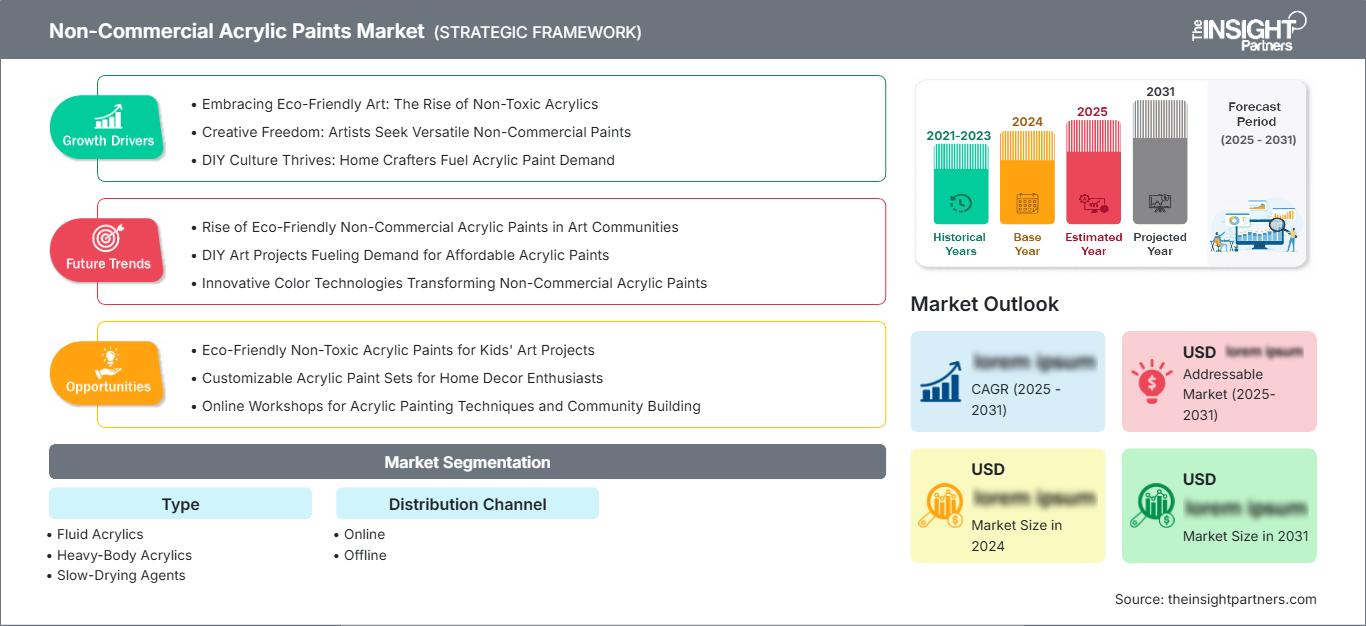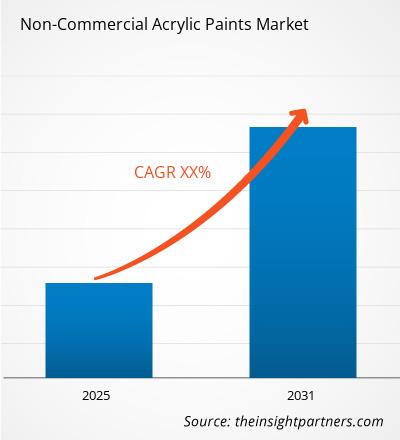Se prevé que el mercado de pinturas acrílicas no comerciales registre un crecimiento sostenido entre 2026 y 2034, con una valoración que crecerá desde el valor base de 2025 y experimentará una expansión sostenida hasta el final del período de pronóstico. Esta tendencia refleja una perspectiva favorable del mercado impulsada por la evolución de los requisitos de la industria y los continuos avances tecnológicos.
El informe se clasifica por tipo (acrílicos fluidos, acrílicos de alta densidad, agentes de secado lento) y analiza el mercado en profundidad según el canal de distribución (en línea, presencial). Se proporciona un desglose completo a nivel global, regional y nacional para cada uno de estos segmentos clave.
El informe incluye el tamaño del mercado y las previsiones para todos los segmentos, con valores en USD. También ofrece estadísticas clave sobre el estado actual del mercado de las principales empresas, junto con información sobre las tendencias actuales del mercado y las oportunidades emergentes.
Propósito del Informe
El informe "Mercado de Pinturas Acrílicas No Comerciales" de The Insight Partners busca describir el panorama actual y el crecimiento futuro, los principales factores impulsores, los desafíos y las oportunidades. Esto proporcionará información a diversas partes interesadas del negocio, como:
- Proveedores/fabricantes de tecnología: Para comprender la dinámica cambiante del mercado y conocer las oportunidades potenciales de crecimiento, lo que les permitirá tomar decisiones estratégicas informadas.
- Inversores: Realizar un análisis exhaustivo de tendencias respecto a la tasa de crecimiento del mercado, las proyecciones financieras del mercado y las oportunidades que existen en toda la cadena de valor.
- Órganos reguladores: Regular las políticas y las actividades policiales en el mercado con el objetivo de minimizar el abuso, preservar la confianza de los inversores y defender la integridad y estabilidad del mercado.
Segmentación del mercado de pinturas acrílicas no comerciales
- Acrílicos fluidos
- Acrílicos de cuerpo pesado
- Agentes de secado lento
Canal de distribución
- En línea
- Desconectado
Obtendrá personalización en cualquier informe, sin cargo, incluidas partes de este informe o análisis a nivel de país, paquete de datos de Excel, así como también grandes ofertas y descuentos para empresas emergentes y universidades.
Mercado de pinturas acrílicas no comerciales: Perspectivas estratégicas

-
Obtenga las principales tendencias clave del mercado de este informe.Esta muestra GRATUITA incluirá análisis de datos, desde tendencias del mercado hasta estimaciones y pronósticos.
Factores que impulsan el crecimiento del mercado de pinturas acrílicas no comerciales
- Adopción del arte ecológico: el auge de los acrílicos no tóxicos
- Libertad creativa: los artistas buscan pinturas versátiles y no comerciales
- La cultura del bricolaje prospera: los artesanos caseros impulsan la demanda de pintura acrílica
Tendencias futuras del mercado de pinturas acrílicas no comerciales
- El auge de las pinturas acrílicas ecológicas no comerciales en las comunidades artísticas
- Los proyectos de arte DIY impulsan la demanda de pinturas acrílicas asequibles
- Tecnologías de color innovadoras que transforman las pinturas acrílicas no comerciales
Oportunidades de mercado para pinturas acrílicas no comerciales
- Pinturas acrílicas ecológicas y no tóxicas para proyectos artísticos infantiles
- Juegos de pintura acrílica personalizables para los amantes de la decoración del hogar
- Talleres en línea sobre técnicas de pintura acrílica y desarrollo comunitario
Perspectivas regionales del mercado de pinturas acrílicas no comerciales
Los analistas de The Insight Partners han explicado detalladamente las tendencias regionales y los factores que influyen en el mercado de pinturas acrílicas no comerciales durante el período de pronóstico. Esta sección también analiza los segmentos y la geografía del mercado de pinturas acrílicas no comerciales en América del Norte, Europa, Asia Pacífico, Oriente Medio y África, y América del Sur y Central.
Alcance del informe de mercado de pinturas acrílicas no comerciales
| Atributo del informe | Detalles |
|---|---|
| Tamaño del mercado en 2025 | US$ XX millones |
| Tamaño del mercado en 2034 | US$ XX millones |
| CAGR global (2026-2034) | XX% |
| Datos históricos | 2021-2024 |
| Período de pronóstico | 2026-2034 |
| Segmentos cubiertos |
Por tipo
|
| Regiones y países cubiertos |
América del norte
|
| Líderes del mercado y perfiles de empresas clave |
|
Densidad de actores del mercado de pinturas acrílicas no comerciales: comprensión de su impacto en la dinámica empresarial
El mercado de pinturas acrílicas no comerciales está creciendo rápidamente, impulsado por la creciente demanda del usuario final debido a factores como la evolución de las preferencias de los consumidores, los avances tecnológicos y una mayor conciencia de los beneficios del producto. A medida que aumenta la demanda, las empresas amplían su oferta, innovan para satisfacer las necesidades de los consumidores y aprovechan las tendencias emergentes, lo que impulsa aún más el crecimiento del mercado.

- Obtenga una descripción general de los principales actores clave del mercado de pinturas acrílicas no comerciales
Puntos clave de venta
- Cobertura integral: el informe cubre de manera integral el análisis de productos, servicios, tipos y usuarios finales del mercado de pinturas acrílicas no comerciales, proporcionando un panorama holístico.
- Análisis de expertos: el informe se compila con base en el conocimiento profundo de expertos y analistas de la industria.
- Información actualizada: El informe asegura relevancia comercial debido a su cobertura de información reciente y tendencias de datos.
- Opciones de personalización: este informe se puede personalizar para satisfacer los requisitos específicos del cliente y adaptarse adecuadamente a las estrategias comerciales.
Por lo tanto, el informe de investigación sobre el mercado de pinturas acrílicas no comerciales puede ayudar a descifrar y comprender el panorama de la industria y sus perspectivas de crecimiento. Si bien existen algunas preocupaciones válidas, las ventajas generales de este informe tienden a superar las desventajas.
- Análisis histórico (2 años), año base, pronóstico (7 años) con CAGR
- Análisis PEST y FODA
- Tamaño del mercado, valor/volumen: global, regional y nacional
- Industria y panorama competitivo
- Conjunto de datos de Excel
Informes recientes
Informes relacionados
Testimonios
Razón para comprar
- Toma de decisiones informada
- Comprensión de la dinámica del mercado
- Análisis competitivo
- Información sobre clientes
- Pronósticos del mercado
- Mitigación de riesgos
- Planificación estratégica
- Justificación de la inversión
- Identificación de mercados emergentes
- Mejora de las estrategias de marketing
- Impulso de la eficiencia operativa
- Alineación con las tendencias regulatorias






















 Obtenga una muestra gratuita para - Mercado de pinturas acrílicas no comerciales
Obtenga una muestra gratuita para - Mercado de pinturas acrílicas no comerciales